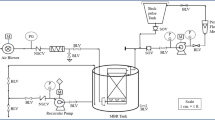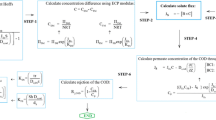Abstract
A user-friendly, menu-driven simulation software tool has been developed for the first time to optimize and analyze the system performance of an advanced continuous membrane-integrated pharmaceutical wastewater treatment plant. The software allows pre-analysis and manipulation of input data which helps in optimization and shows the software performance visually on a graphical platform. Moreover, the software helps the user to “visualize” the effects of the operating parameters through its model-predicted output profiles. The software is based on a dynamic mathematical model, developed for a systematically integrated forward osmosis-nanofiltration process for removal of toxic organic compounds from pharmaceutical wastewater. The model-predicted values have been observed to corroborate well with the extensive experimental investigations which were found to be consistent under varying operating conditions like operating pressure, operating flow rate, and draw solute concentration. Low values of the relative error (RE = 0.09) and high values of Willmott-d-index (d will = 0.981) reflected a high degree of accuracy and reliability of the software. This software is likely to be a very efficient tool for system design or simulation of an advanced membrane-integrated treatment plant for hazardous wastewater.











Similar content being viewed by others
References
Anna VS, Marczak LDF, Tessaro IC (2012) Membrane concentration of liquid foods by forward osmosis: process and quality view. J Food Eng 111:483–489
APHA (1995) Standard methods, 19th edn. Public Health Association, Washington, DC, American Public Health Association, Washington, DC
Bowen WR, Welfoot JS, Williams PM (2002) Linearized transport model for nanofiltration: development and assessment. AICHE J 48:760–773
Chakrabortty S, Sen M, Pal P (2013a) Arsenic removal from contaminated groundwater by membrane-integrated hybrid plant: optimization and control using visual basic platform. Environ Sci Pollut Res 21(5):3840–3857
Chakrabortty S, Roy M, Pal P (2013b) Removal of fluoride from contaminated groundwater by cross flow nanofiltration: transport modeling and economic evaluation. Desalination 313:115–124
Dresner L (1972) Some remarks on the integration of extended Nernst–Planck equation in the hyper filtration of multicomponent solutions. Desalination 10:27–46
Fujioka T, Khan SJ, McDonald JA, Roux A, Poussade Y, Drewes JE, Nghiem LD (2014) N-nitrosamine rejection by reverse osmosis: effects of membrane exposure to chemical cleaning reagents. Desalination 343:60–66
Gaunt PN, Piddock LJV (1996) Ciprofloxacin resistant Campylobacter spp. in humans: an epidemiological and laboratory study. J Antimicrob Chemother 37:747–757
Gogate PR, Pandit AB (2004) A review of imperative technologies for wastewater treatment I: oxidation technologies at ambient conditions. Adv Environ Res 8:501–551
Hancock NT, Cath TY (2009) Solute coupled diffusion in osmotically driven membrane processes. Environ Sci Technol 43:6769–6775
Kostich MS, Batt AL, Lazorchak JM (2014) Concentrations of prioritized pharmaceuticals in effluents from 50 large wastewater treatment plants in the US and implications for risk estimation. Environ Pollut 184:354–359
Kumar R, Bhakta P, Chakrabortty S, Pal P (2011) Separating cyanide from coke wastewater by cross flow nanofiltration. Sep Sci Technol 46:2119–2127
Murthy ZVP, Gupta SK (1997) Estimation of mass-transfer coefficient using a combined nonlinear membrane transport and film theory. Desalination 109:39–49
Pal P, Ahammad Z, Pattanayek A, Bhattacharya P (2007) ARSEPPA: a visual basic software tool for arsenic separation plant performance analysis. Chem Eng J 129(1–4):113–122
Pal P, Kumar R, Srivastava N, Chowdhury J (2014) A visual basic simulation software tool for performance analysis of a membrane-based advanced water treatment plant. Environ Sci Pollut Res 21:1833–1849
Rehman MS, Rashid N, Ashfaq M, Saif A, Ahmad N, Jong-In H (2013) Global risk of pharmaceutical contamination from highly populated developing countries. Chemosphere 138:1045–1055
Sentaa I, Mato M, Jakopovic HK, Terzica S, Urkob J, Mijatovi I, Ahel M (2011) Removal of antimicrobials using advanced wastewater treatment. J Hazard Mater 192:319–328
Shah AD, Huang C, Kim J (2012) Mechanisms of antibiotic removal by nanofiltration membranes: model development and application. J Membr Sci 389:234–244
Tewari S, Jindal R, Kho YL, Eo S, Choi K (2013) Major pharmaceutical residues in wastewater treatment plants and receiving waters in Bangkok, Thailand, and associated ecological risks. Chemosphere 91(5):697–704
Thakura R, Chakrabortty S, Pal P (2015) Treating complex industrial wastewater in a new membrane integrated closed loop system for recovery and reuse. Clean Techn Environ Policy. doi:10.1007/s10098-015-0971-4
Yoon Y, Westerhoff P, Snyder SA, Wert EC, Yoon J (2007) Removal of endocrine disrupting compounds and pharmaceuticals by nanofiltration and ultrafiltration membranes. Desalination 202:16–23
Zhao S, Zou L (2011) Effects of working temperature on separation performance, membrane scaling and cleaning in forward osmosis desalination. Desalination 278:157–164
Acknowledgments
The authors are grateful to the Department of Science and Technology, Government of India, for the financial support through DST-FIST and DST-INSPIRE program (DST/INSPIRE Fellowship/2012/271).
Author information
Authors and Affiliations
Corresponding author
Additional information
Responsible editor: Bingcai Pan
Rights and permissions
About this article
Cite this article
Pal, P., Thakura, R. & Chakrabortty, S. Performance analysis and optimization of an advanced pharmaceutical wastewater treatment plant through a visual basic software tool (PWWT.VB). Environ Sci Pollut Res 23, 9901–9917 (2016). https://doi.org/10.1007/s11356-016-6238-8
Received:
Accepted:
Published:
Issue Date:
DOI: https://doi.org/10.1007/s11356-016-6238-8




